北师大版高二英语6教案:unit18Lesson1WhatIsBeauty
北师大版高中英语选修6 Unit18_Lesson1_公开课教学设计(一)
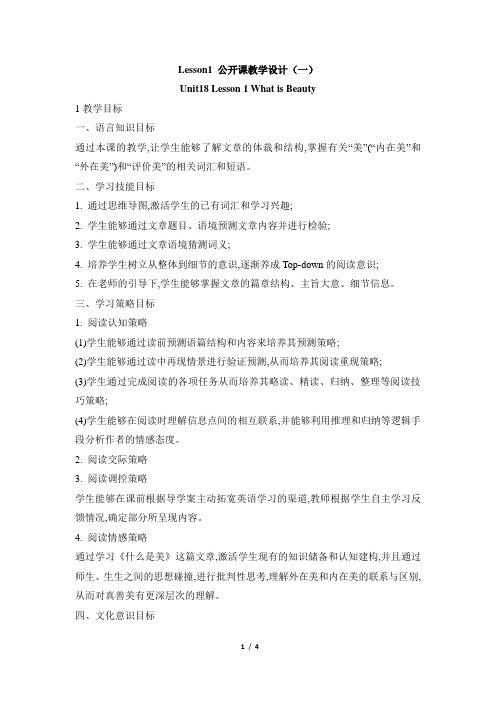
Lesson1 公开课教学设计(一)Unit18 Lesson 1 What is Beauty1教学目标一、语言知识目标通过本课的教学,让学生能够了解文章的体裁和结构,掌握有关“美”(“内在美”和“外在美”)和“评价美”的相关词汇和短语。
二、学习技能目标1. 通过思维导图,激活学生的已有词汇和学习兴趣;2. 学生能够通过文章题目、语境预测文章内容并进行检验;3. 学生能够通过文章语境猜测词义;4. 培养学生树立从整体到细节的意识,逐渐养成Top-down的阅读意识;5. 在老师的引导下,学生能够掌握文章的篇章结构、主旨大意、细节信息。
三、学习策略目标1. 阅读认知策略(1)学生能够通过读前预测语篇结构和内容来培养其预测策略;(2)学生能够通过读中再现情景进行验证预测,从而培养其阅读重现策略;(3)学生通过完成阅读的各项任务从而培养其略读、精读、归纳、整理等阅读技巧策略;(4)学生能够在阅读时理解信息点间的相互联系,并能够利用推理和归纳等逻辑手段分析作者的情感态度。
2. 阅读交际策略3. 阅读调控策略学生能够在课前根据导学案主动拓宽英语学习的渠道,教师根据学生自主学习反馈情况,确定部分所呈现内容。
4. 阅读情感策略通过学习《什么是美》这篇文章,激活学生现有的知识储备和认知建构,并且通过师生、生生之间的思想碰撞,进行批判性思考,理解外在美和内在美的联系与区别,从而对真善美有更深层次的理解。
四、文化意识目标1. 学生通过学习文本,了解并认识美的标准和美的载体形式等;2. 学生能够理解美是相对的,不同文化、社会、历史人对于美的评判标准也是不同的。
3. 学生能够了解中西方文化对于beauty在价值观念和思维方式上的不同,提高中外文化差异敏感性和鉴别能力,发展跨文化交际能力。
五、情感态度目标1. 学生能够自信地表达自己的观点,能够通过小组合作培养其团队合作的精神。
2. 能够客观辩证地看到“美”,而且对于不同的“外在美”持包容的态度,并且能够意识到“内在美”才是真正的美,要保持一种善于发现美、创造美、欣赏美的态度。
北师大版高中英语选修6 Unit18_Lesson1_公开课教学设计(二)
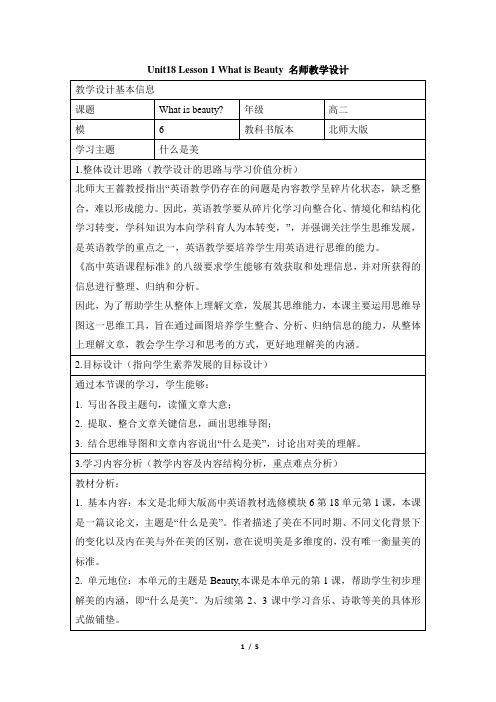
生成性成果:在读懂文章大意的基础上以及问题的引导下,大部分学生基本能够根据自己的思路画出思维导图,并结合思维导图说出自己对美的理解。
具体问题及改进措施:
1.在画思维导图前,通过问题的形式对学生的画图做了引导,引导一起画出了主体结构,在此基础上再让学生自主画图,这一做法虽考虑到学生的学情,但对其思路有所限制。应在今后对画思维导图做更多的训练,学生的逻辑思维能力得到进一步发展之后,让学生真正自主完成。
4.学情分析(学生现状与需求分析)
自然情况:
北京实验学校高二年级理科实验班学生,共40人。学生的英语水平普遍在中等程度,有一定的阅读能力和技巧,愿意与老师同学沟通。但大多数学生的词汇量不足,对于自己的英语水平并不自信,遇到生词较多的文章和难度的问题,大都不善于表达自己的观点。已知起点:
1)话题:本文的主题是Beauty,学生在模块2第6单元Design学习了对绘画、建筑和一些其他艺术品的鉴赏,对于判断什么是美,怎样欣赏美有了一定的基础,而且学生日常对“美”这一话题接触较多,对“美”都有自己的评判标准。但是,对作者提出的“美是多维度的”这一观点仍缺乏深刻的认识。
步骤4:细读课文并画思维导图:
教师:首先通过提问,引导学生一起列出本文的主体结构,即画出思维导图的主要结构。然后让学生细读课文,在2个问题的引导下继续完成几个段落的思维导图,并请学生在小组内或上讲台与大家分享自己的画图思路。老师的带领全班总结出本文的主旨。
学生:在老师的带领下细读课文,完成思维导图,并在小组内与同学分享自己的画图思路,理清文章逻辑,了解作者的写作意图。
《高中英语课程标准》的八级要求学生能够有效获取和处理信息,并对所获得的信息进行整理、归纳和分析。
Unit18 lesson1《what’s beauty》教案(北师大选修6)
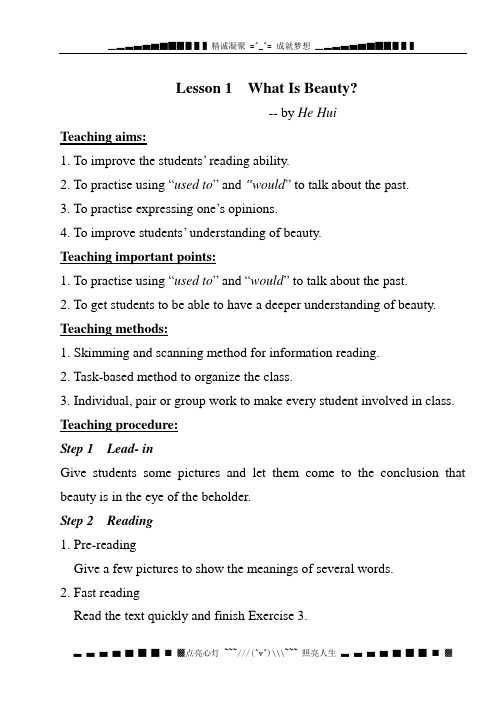
Lesson 1 What Is Beauty?-- by He HuiTeaching aims:1. To improve the students’ reading ability.2. To practise using “used to” and “would” to talk about the past.3. To practise expressing one’s opinions.4. To improve students’ understanding of beauty.Teaching important points:1. To practise using “used to” and “would” to talk about the past.2. To get students to be able to have a deeper understanding of beauty. Teaching methods:1. Skimming and scanning method for information reading.2. Task-based method to organize the class.3. Individual, pair or group work to make every student involved in class. Teaching procedure:Step 1 Lead- inGive students some pictures and let them come to the conclusion that beauty is in the eye of the beholder.Step 2 Reading1. Pre-readingGive a few pictures to show the meanings of several words.2. Fast readingRead the text quickly and finish Exercise 3.3. ReadingRead the text again and finish Exercise 4.4. Intensive readingFinish the true or false questions.5. Oral practice1) Finish Exercise 5.2) Show students two pictures about artificial beauty and ask them to voice their opinions on this matter.6. Language pointsStep 3 Grammar about the usage of used to and would1. Find out the expressions “used to” and “would” from the text.2. Practise the grammar point by talking about the things in our daily life. There have been many changes taken place in our school in the recent years, can you tell me some?3. Discussion1) Find out some examples about the beauty.●beauty of nature●beauty of language●beauty of behavior●beauty of soul2) As a student, how can you make the world and yourself become more beautiful?Homework: <<英语周报>>配套练习。
英语北师大版必修6 Unit18 Beauty Lesson 1 What Is Beauty
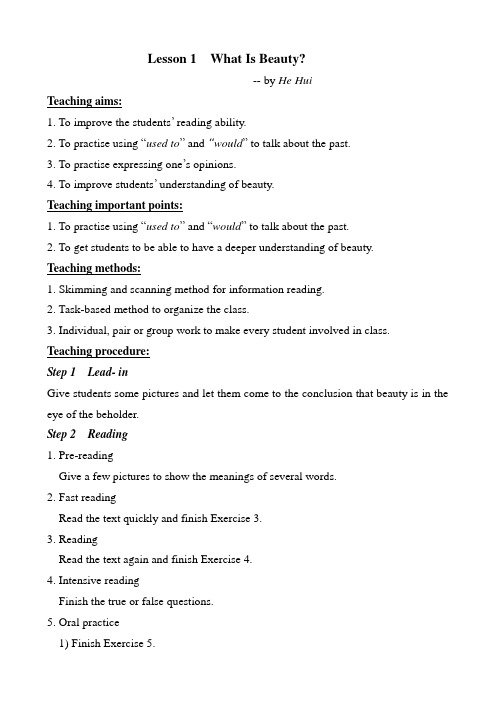
Lesson 1 What Is Beauty?-- by He HuiTeaching aims:1. To improve the students’ reading ability.2. To practise using “used to” and “would” to talk about the past.3. To practise expressing one’s opinions.4. To improve students’ understanding of beauty.Teaching important points:1. To practise using “used to” and “would” to talk about the past.2. To get students to be able to have a deeper understanding of beauty.Teaching methods:1. Skimming and scanning method for information reading.2. Task-based method to organize the class.3. Individual, pair or group work to make every student involved in class. Teaching procedure:Step 1 Lead- inGive students some pictures and let them come to the conclusion that beauty is in the eye of the beholder.Step 2 Reading1. Pre-readingGive a few pictures to show the meanings of several words.2. Fast readingRead the text quickly and finish Exercise 3.3. ReadingRead the text again and finish Exercise 4.4. Intensive readingFinish the true or false questions.5. Oral practice1) Finish Exercise 5.2) Show students two pictures about artificial beauty and ask them to voice their opinions on this matter.6. Language pointsStep 3 Grammar about the usage of used to and would1. Find out the expressions “used to” and “would” from the text.2. Practise the grammar point by talking about the things in our daily life.There have been many changes taken place in our school in the recent years, can you tell me some?3. Discussion1) Find out some examples about the beauty.●beauty of nature●beauty of language●beauty of behavior●beauty of soul2) As a student, how can you make the world and yourself become more beautiful? Homework: <<英语周报>>配套练习。
北师大版高二英语必修6_Unit18_Lesson1_优教精品课件
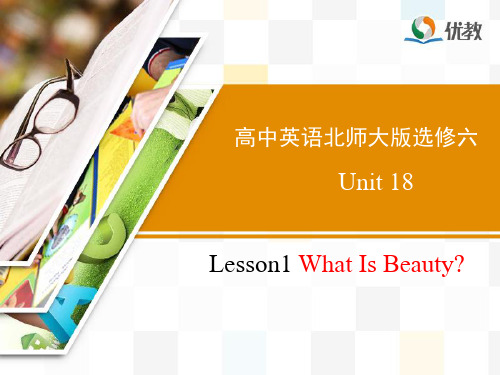
Supporting details
to achieve a body shape
to be attractive
as an addition to costumes to show family associations to mark criminals Young women follow slimming diets to lose extra kilos in preparation for wedding day
Careful reading
adapt with
Time
Example
In 19th century
corsets
woolen shawls
In the past tattoo or body art
In some countries
Culture In other cultures
weight
Beauty is quite different in the eye of different people.
Beauty is in the eye of the beholder.
“情人眼里出西施”
Fast reading
Let’s learn the new words (Part3-P34)
Fast reading
consistent woolen
overweight commitment
die out accompany a wide range of subjective dimension
never changing made of wool fat responsibility or promise disappear completely go together with a variety of a personal view or opinion part of situation
北师大版高二英语教案

北师大版高二英语教案【篇一:北师大版unit18 lesson1 教学设计】unit 18 lesson 1 what is beauty (first period)教学设计教材分析:本篇课文是一篇议论文,学生对于什么是“美”这个话题并不陌生。
文章开头提出论点beauty is in the eye of thebeholder ,文章中间部分是重点内容,主要提出分论点,通过演绎,举例,对比逐一进行论证,最后一段归纳概括得出结论——we are influenced by our culture , our biology and our time in historyto notice physical beauty quickly and easily , but it is inner beauty that requires us to truly see .这篇文章论点明确,论据充分,篇章结构清楚,对学生阅读能力的培养则是教学的难点。
【教学过程及设计意图】教学反思:这一节是阅读课,话题是:“what is beauty?”,目的在于要训练学生的阅读技巧,还在于让学生了解两种美:外在美和内在美。
而外在美则受社会,时间和文化的影响,产生不同的变化,进而要让学生意识到内在美的重要性和善于发现生活中存在的真美。
这节课主要采取任务型教学法,用多媒体辅助教学,让学生进行双人或小组活动,使学生参与到课堂教学当中。
这节课首先用四幅风景的图片让学生发表自己的看法:在他们自己的眼中,哪一幅是最漂亮的。
由此引出“beauty is in the eye of the beholder.”这一句谚语。
然后让学生进行快速阅读,找出为什么我们会说情人眼里出西施以及有哪几种美这两个问题的答案。
由于文章明显地按照外在美和内在美两个部分进行阐述,所以在快速阅读以后,教师有意识地引导学生进行篇章结构的划分。
接着再次要求学生快速阅读外在美部分,找出影响人们理解美的因素。
Unit 18 Beauty Lesson1 What is beauty 教学设计 2-优质公开课-北师大选修6精品
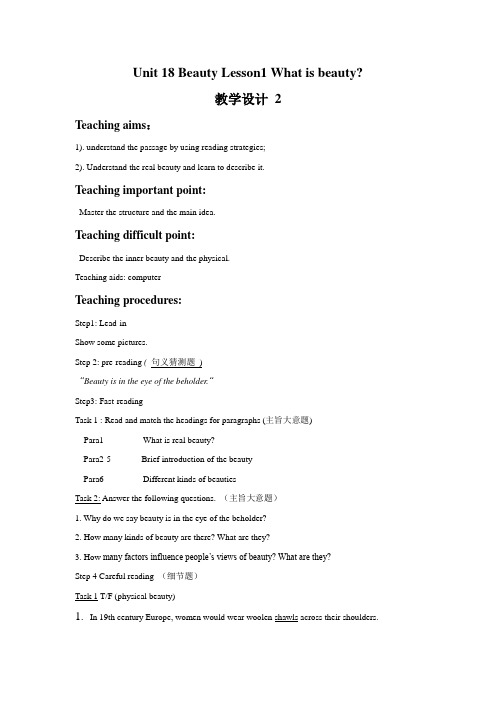
Unit 18 Beauty Lesson1 What is beauty?教学设计2Teaching aims:1). understand the passage by using reading strategies;2). Understand the real beauty and learn to describe it.Teaching important point:Master the structure and the main idea.Teaching difficult point:Describe the inner beauty and the physical.Teaching aids: computerTeaching procedures:Step1: Lead-inShow some pictures.Step 2: pre-reading ( 句义猜测题)“Beauty is in the eye of the beholder.”Step3: Fast-readingTask 1 : Read and match the headings for paragraphs (主旨大意题)Para1 What is real beauty?Para2-5 Brief introduction of the beautyPara6 Different kinds of beautiesTask 2: Answer the following questions. (主旨大意题)1. Why do we say beauty is in the eye of the beholder?2. How many kinds of beauty are there? What are they?3. How many factors influence people’s views of beauty? What are they?Step 4 Careful reading (细节题)Task 1 T/F (physical beauty)1.In 19th century Europe, women would wear woolen shawls across their shoulders.2.Nowadays, tattoos are used to mark criminals.3.In some countries, young women follow slimming diets to lose extra kilos to prepare for theirwedding day.4. The human race would die out if we perceived physical beauty in the same wayTask 2 Fill in the blanks. (Inner beauty)1._____ beauty must ____________ physical beauty.2. Inner beauty is found in a wide __________ of personal _______. E.g. kindness, warmth, a healthy conscience, etc.3. Judging the appeal of inner beauty is much more ________.4. Beauty has more than one____________and _________ beauty requires us to truly see.Step5: Post-readingCan you work out the main structure of the whole passage?Step 6: summaryStep7: V oice your opinions.Who is the most beautiful person in your eyes?Which is more important, physical beauty or inner beauty?Basic adjectivesPhysical beauty:handsome; good-looking; attractive; brilliant; beautiful; pretty; attractive; elegant…Inner beauty:kind-hearted; patient; hard-working; confident; gentle; humorous; generous ...Basic expressionsI think/ in my opinion/in my eye s/As far as concerned…As we know, as is known to us all,What's more/moreover/in addition?Generally/Frankly speakingStep 8: HomeworkLook for the true beauty around us!Beauty is everywhere; for us, we don’t lack beauty but lack discovery.Be good at finding beauty. Be willing to create beauty. Be pleased to enjoy beauty.Thank you for your listening!。
高中英语北师大版模块6【教学设计】Unit 18 Lesson 1
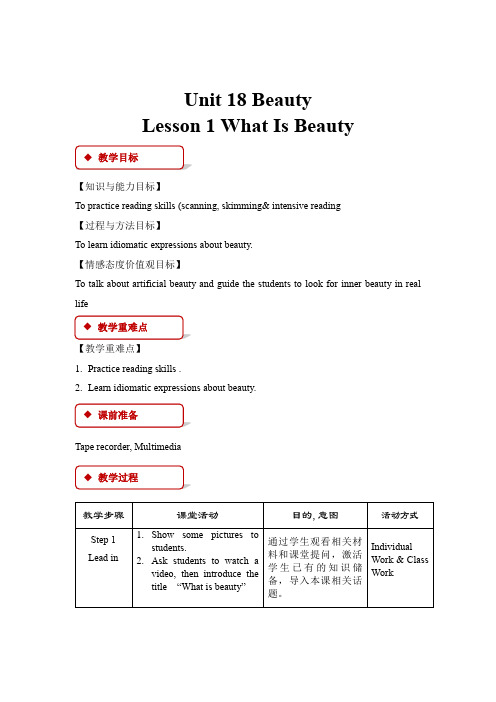
Individual Work & Class Work
Step 6
Homework
1.Reviewthe text after class.
2.Findout the usage
“would”and“used to”
【情感态度价值观目标】
To talk about artificial beauty and guide the students to look for inner beauty in real life
【教学重难点】
1.Practice reading skills.
2.Learn idiomatic expressions about beauty.
Tape recorder, Multimedia
教学步骤
课堂活动
目的,意图
活动方式
Step 1
Lead in
1.Show some pictures to students.
2.Ask students to watch a video, then introduce the title“What is beauty”
Unit18Beauty
Lesson 1What Is Beauty
【知识与能力目标】
To practice reading skills (scanning, skimming& intensive reading
【过程与方法目标】
To learn idiomatic expressions about beauty.
